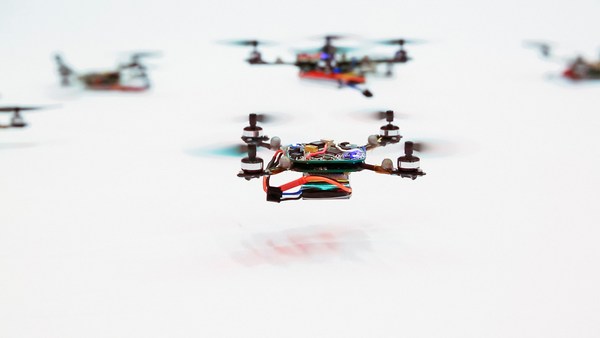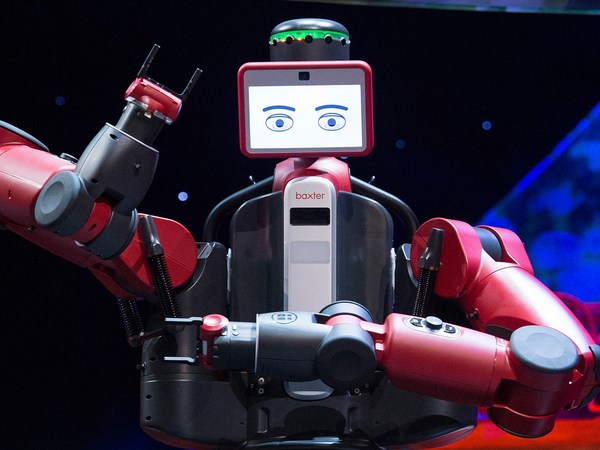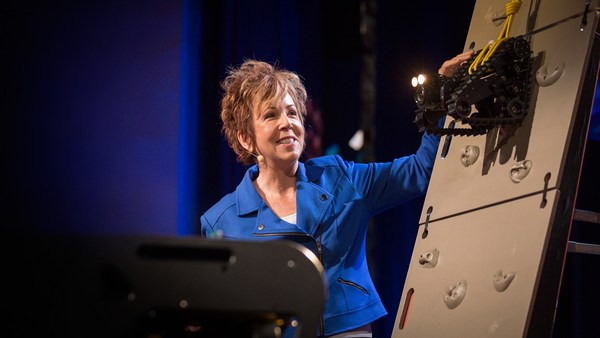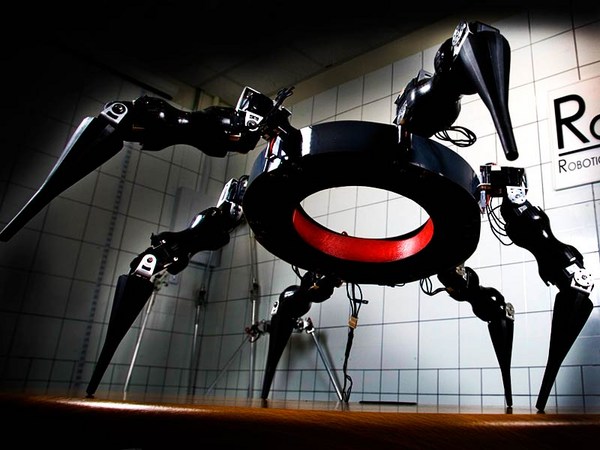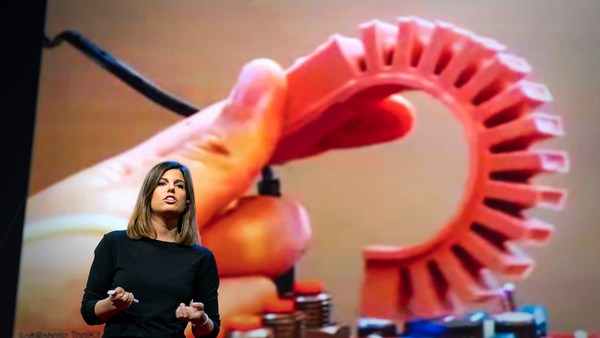This is Pleurobot. Pleurobot is a robot that we designed to closely mimic a salamander species called Pleurodeles waltl. Pleurobot can walk, as you can see here, and as you'll see later, it can also swim.
So you might ask, why did we design this robot? And in fact, this robot has been designed as a scientific tool for neuroscience. Indeed, we designed it together with neurobiologists to understand how animals move, and especially how the spinal cord controls locomotion. But the more I work in biorobotics, the more I'm really impressed by animal locomotion. If you think of a dolphin swimming or a cat running or jumping around, or even us as humans, when you go jogging or play tennis, we do amazing things. And in fact, our nervous system solves a very, very complex control problem. It has to coordinate more or less 200 muscles perfectly, because if the coordination is bad, we fall over or we do bad locomotion. And my goal is to understand how this works.
There are four main components behind animal locomotion. The first component is just the body, and in fact we should never underestimate to what extent the biomechanics already simplify locomotion in animals. Then you have the spinal cord, and in the spinal cord you find reflexes, multiple reflexes that create a sensorimotor coordination loop between neural activity in the spinal cord and mechanical activity. A third component are central pattern generators. These are very interesting circuits in the spinal cord of vertebrate animals that can generate, by themselves, very coordinated rhythmic patterns of activity while receiving only very simple input signals. And these input signals coming from descending modulation from higher parts of the brain, like the motor cortex, the cerebellum, the basal ganglia, will all modulate activity of the spinal cord while we do locomotion. But what's interesting is to what extent just a low-level component, the spinal cord, together with the body, already solve a big part of the locomotion problem. You probably know it by the fact that you can cut the head off a chicken, it can still run for a while, showing that just the lower part, spinal cord and body, already solve a big part of locomotion.
Now, understanding how this works is very complex, because first of all, recording activity in the spinal cord is very difficult. It's much easier to implant electrodes in the motor cortex than in the spinal cord, because it's protected by the vertebrae. Especially in humans, very hard to do. A second difficulty is that locomotion is really due to a very complex and very dynamic interaction between these four components. So it's very hard to find out what's the role of each over time. This is where biorobots like Pleurobot and mathematical models can really help.
So what's biorobotics? Biorobotics is a very active field of research in robotics where people want to take inspiration from animals to make robots to go outdoors, like service robots or search and rescue robots or field robots. And the big goal here is to take inspiration from animals to make robots that can handle complex terrain -- stairs, mountains, forests, places where robots still have difficulties and where animals can do a much better job. The robot can be a wonderful scientific tool as well. There are some very nice projects where robots are used, like a scientific tool for neuroscience, for biomechanics or for hydrodynamics. And this is exactly the purpose of Pleurobot. So what we do in my lab is to collaborate with neurobiologists like Jean-Marie Cabelguen, a neurobiologist in Bordeaux in France, and we want to make spinal cord models and validate them on robots. And here we want to start simple.
So it's good to start with simple animals like lampreys, which are very primitive fish, and then gradually go toward more complex locomotion, like in salamanders, but also in cats and in humans, in mammals. And here, a robot becomes an interesting tool to validate our models. And in fact, for me, Pleurobot is a kind of dream becoming true. Like, more or less 20 years ago I was already working on a computer making simulations of lamprey and salamander locomotion during my PhD. But I always knew that my simulations were just approximations. Like, simulating the physics in water or with mud or with complex ground, it's very hard to simulate that properly on a computer. Why not have a real robot and real physics? So among all these animals, one of my favorites is the salamander. You might ask why, and it's because as an amphibian, it's a really key animal from an evolutionary point of view. It makes a wonderful link between swimming, as you find it in eels or fish, and quadruped locomotion, as you see in mammals, in cats and humans. And in fact, the modern salamander is very close to the first terrestrial vertebrate, so it's almost a living fossil, which gives us access to our ancestor, the ancestor to all terrestrial tetrapods.
So the salamander swims by doing what's called an anguilliform swimming gait, so they propagate a nice traveling wave of muscle activity from head to tail. And if you place the salamander on the ground, it switches to what's called a walking trot gait. In this case, you have nice periodic activation of the limbs which are very nicely coordinated with this standing wave undulation of the body, and that's exactly the gait that you are seeing here on Pleurobot. Now, one thing which is very surprising and fascinating in fact is the fact that all this can be generated just by the spinal cord and the body. So if you take a decerebrated salamander -- it's not so nice but you remove the head -- and if you electrically stimulate the spinal cord, at low level of stimulation this will induce a walking-like gait. If you stimulate a bit more, the gait accelerates. And at some point, there's a threshold, and automatically, the animal switches to swimming. This is amazing. Just changing the global drive, as if you are pressing the gas pedal of descending modulation to your spinal cord, makes a complete switch between two very different gaits. And in fact, the same has been observed in cats. If you stimulate the spinal cord of a cat, you can switch between walk, trot and gallop. Or in birds, you can make a bird switch between walking, at a low level of stimulation, and flapping its wings at high-level stimulation. And this really shows that the spinal cord is a very sophisticated locomotion controller.
So we studied salamander locomotion in more detail, and we had in fact access to a very nice X-ray video machine from Professor Martin Fischer in Jena University in Germany. And thanks to that, you really have an amazing machine to record all the bone motion in great detail. That's what we did. So we basically figured out which bones are important for us and collected their motion in 3D. And what we did is collect a whole database of motions, both on ground and in water, to really collect a whole database of motor behaviors that a real animal can do. And then our job as roboticists was to replicate that in our robot. So we did a whole optimization process to find out the right structure, where to place the motors, how to connect them together, to be able to replay these motions as well as possible. And this is how Pleurobot came to life.
So let's look at how close it is to the real animal. So what you see here is almost a direct comparison between the walking of the real animal and the Pleurobot. You can see that we have almost a one-to-one exact replay of the walking gait. If you go backwards and slowly, you see it even better. But even better, we can do swimming. So for that we have a dry suit that we put all over the robot --
(Laughter)
and then we can go in water and start replaying the swimming gaits. And here, we were very happy, because this is difficult to do. The physics of interaction are complex. Our robot is much bigger than a small animal, so we had to do what's called dynamic scaling of the frequencies to make sure we had the same interaction physics. But you see at the end, we have a very close match, and we were very, very happy with this. So let's go to the spinal cord. So here what we did with Jean-Marie Cabelguen is model the spinal cord circuits. And what's interesting is that the salamander has kept a very primitive circuit, which is very similar to the one we find in the lamprey, this primitive eel-like fish, and it looks like during evolution, new neural oscillators have been added to control the limbs, to do the leg locomotion. And we know where these neural oscillators are but what we did was to make a mathematical model to see how they should be coupled to allow this transition between the two very different gaits. And we tested that on board of a robot.
And this is how it looks. So what you see here is a previous version of Pleurobot that's completely controlled by our spinal cord model programmed on board of the robot. And the only thing we do is send to the robot through a remote control the two descending signals it normally should receive from the upper part of the brain. And what's interesting is, by playing with these signals, we can completely control speed, heading and type of gait. For instance, when we stimulate at a low level, we have the walking gait, and at some point, if we stimulate a lot, very rapidly it switches to the swimming gait. And finally, we can also do turning very nicely by just stimulating more one side of the spinal cord than the other. And I think it's really beautiful how nature has distributed control to really give a lot of responsibility to the spinal cord so that the upper part of the brain doesn't need to worry about every muscle. It just has to worry about this high-level modulation, and it's really the job of the spinal cord to coordinate all the muscles.
So now let's go to cat locomotion and the importance of biomechanics. So this is another project where we studied cat biomechanics, and we wanted to see how much the morphology helps locomotion. And we found three important criteria in the properties, basically, of the limbs. The first one is that a cat limb more or less looks like a pantograph-like structure. So a pantograph is a mechanical structure which keeps the upper segment and the lower segments always parallel. So a simple geometrical system that kind of coordinates a bit the internal movement of the segments. A second property of cat limbs is that they are very lightweight. Most of the muscles are in the trunk, which is a good idea, because then the limbs have low inertia and can be moved very rapidly. The last final important property is this very elastic behavior of the cat limb, so to handle impacts and forces. And this is how we designed Cheetah-Cub.
So let's invite Cheetah-Cub onstage. So this is Peter Eckert, who does his PhD on this robot, and as you see, it's a cute little robot. It looks a bit like a toy, but it was really used as a scientific tool to investigate these properties of the legs of the cat. So you see, it's very compliant, very lightweight, and also very elastic, so you can easily press it down and it will not break. It will just jump, in fact. And this very elastic property is also very important. And you also see a bit these properties of these three segments of the leg as pantograph.
Now, what's interesting is that this quite dynamic gait is obtained purely in open loop, meaning no sensors, no complex feedback loops. And that's interesting, because it means that just the mechanics already stabilized this quite rapid gait, and that really good mechanics already basically simplify locomotion. To the extent that we can even disturb a bit locomotion, as you will see in the next video, where we can for instance do some exercise where we have the robot go down a step, and the robot will not fall over, which was a surprise for us. This is a small perturbation. I was expecting the robot to immediately fall over, because there are no sensors, no fast feedback loop. But no, just the mechanics stabilized the gait, and the robot doesn't fall over. Obviously, if you make the step bigger, and if you have obstacles, you need the full control loops and reflexes and everything. But what's important here is that just for small perturbation, the mechanics are right. And I think this is a very important message from biomechanics and robotics to neuroscience, saying don't underestimate to what extent the body already helps locomotion.
Now, how does this relate to human locomotion? Clearly, human locomotion is more complex than cat and salamander locomotion, but at the same time, the nervous system of humans is very similar to that of other vertebrates. And especially the spinal cord is also the key controller for locomotion in humans. That's why, if there's a lesion of the spinal cord, this has dramatic effects. The person can become paraplegic or tetraplegic. This is because the brain loses this communication with the spinal cord. Especially, it loses this descending modulation to initiate and modulate locomotion. So a big goal of neuroprosthetics is to be able to reactivate that communication using electrical or chemical stimulations. And there are several teams in the world that do exactly that, especially at EPFL. My colleagues Grégoire Courtine and Silvestro Micera, with whom I collaborate.
But to do this properly, it's very important to understand how the spinal cord works, how it interacts with the body, and how the brain communicates with the spinal cord. This is where the robots and models that I've presented today will hopefully play a key role towards these very important goals.
Thank you.
(Applause)
Bruno Giussani: Auke, I've seen in your lab other robots that do things like swim in pollution and measure the pollution while they swim. But for this one, you mentioned in your talk, like a side project, search and rescue, and it does have a camera on its nose.
Auke Ijspeert: Absolutely. So the robot -- We have some spin-off projects where we would like to use the robots to do search and rescue inspection, so this robot is now seeing you. And the big dream is to, if you have a difficult situation like a collapsed building or a building that is flooded, and this is very dangerous for a rescue team or even rescue dogs, why not send in a robot that can crawl around, swim, walk, with a camera onboard to do inspection and identify survivors and possibly create a communication link with the survivor.
BG: Of course, assuming the survivors don't get scared by the shape of this.
AI: Yeah, we should probably change the appearance quite a bit, because here I guess a survivor might die of a heart attack just of being worried that this would feed on you. But by changing the appearance and it making it more robust, I'm sure we can make a good tool out of it.
BG: Thank you very much. Thank you and your team.
